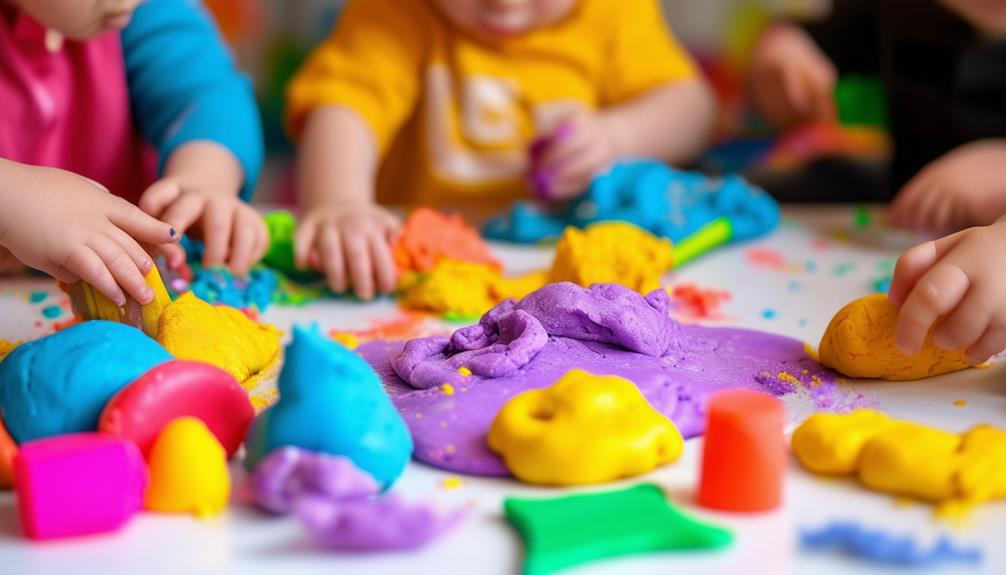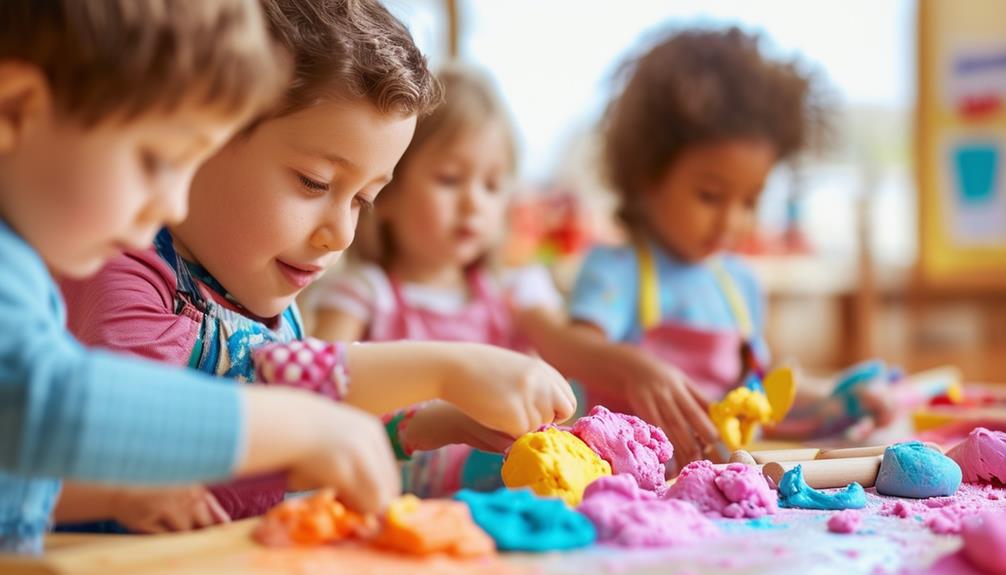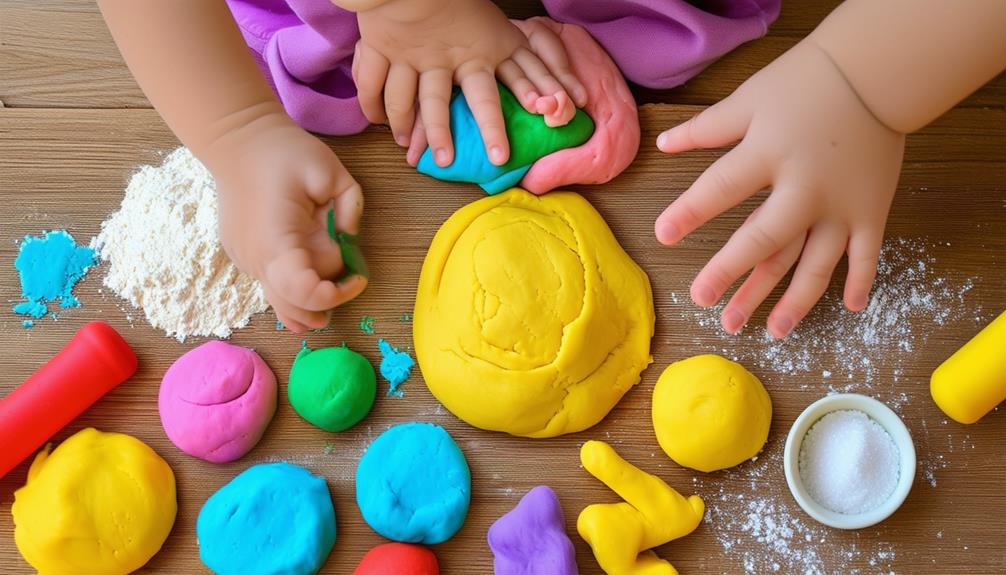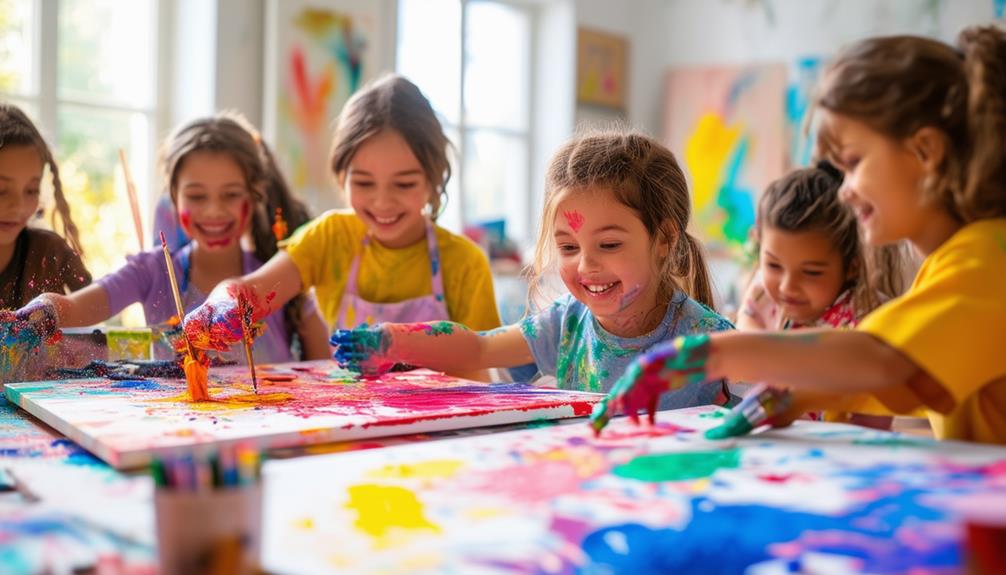Playdough for Special Needs: Benefits and Activities

Introducing playdough to children with special needs offers more than just a fun activity; it serves as a comprehensive tool for enhancing cognitive, sensory, and motor skills. This adaptable medium can be customized to meet individual needs, aiding in the development of problem-solving abilities, language acquisition, and social interaction. By incorporating playdough into learning routines, you can create a transformative educational experience. So, what specific activities and methods can maximize these benefits? The potential of this simple material to make a significant impact on a child's growth is remarkable and worth exploring further.
Educational Benefits
Engaging children with special needs in playdough activities yields numerous educational benefits, including enhanced cognitive development, improved problem-solving skills, and increased creativity. The hands-on nature of playdough helps kids develop essential cognitive skills such as shape recognition and basic math concepts. This interactive method introduces educational elements without the pressure associated with traditional learning.
Playdough activities also promote problem-solving abilities. By manipulating the material, children experiment with cause and effect, learning how different pressures and movements create various forms. This trial-and-error approach enhances critical thinking and problem-solving skills.
Moreover, playdough sessions nurture creativity. Children can mold anything their imagination envisions, from animals to abstract designs, fostering creative thinking and boosting their confidence.
Sensory Development
Engaging with playdough stimulates multiple senses, making it a powerful tool for sensory development in children with special needs. When children manipulate playdough, they encounter a variety of textures and temperatures, providing crucial sensory input. This type of sensory play is especially beneficial for those with sensory processing difficulties, helping them explore and become more comfortable with different sensory experiences.
Using playdough can also support emotional regulation. The repetitive motions of squishing, rolling, and shaping the dough have a calming effect, aiding in self-regulation and reducing anxiety. This makes playdough a valuable resource for managing emotions in children with special needs.
Adding scents to playdough further enhances these sensory experiences. Scented playdough introduces another layer of sensory input, engaging the sense of smell and making the activity more immersive. This multi-sensory approach not only enriches the play experience but also helps children with special needs develop a stronger connection to their sensory environment. Incorporating scented playdough into sensory play creates a more comprehensive and beneficial activity for sensory development.
Fine Motor Skills

Engaging with playdough can significantly enhance fine motor skills in children with special needs. Activities involving playdough improve hand strength, dexterity, and coordination through simple tasks like shaping, pinching, and molding. These actions are crucial for intrinsic muscle strengthening and finger isolation, essential components of fine motor control.
Incorporating tools such as rolling pins and cutters during playdough activities adds extra benefits. These tools not only make the experience more engaging but also effectively strengthen the small muscles in the hands. Additionally, sensory treasure hunts—where small objects are hidden in the playdough—provide an additional layer of fine motor skill development.
Here is a quick overview of how different playdough activities and tools benefit fine motor skills:
| Playdough Activity | Fine Motor Skills Benefit |
|---|---|
| Shaping and Molding | Intrinsic muscle strengthening |
| Pinching and Rolling | Hand strength and finger isolation |
| Using Rolling Pins | Improves dexterity and coordination |
| Sensory Treasure Hunts | Enhances fine motor task precision |
These activities are not only enjoyable but also serve as an excellent method for developing essential motor skills. So, gather some playdough and tools, and observe the improvement in fine motor skills for your child with special needs!
Creativity and Imagination
Engaging your child in playdough activities promotes creativity and imagination through storytelling and thematic play. They can create their own worlds and characters, enhancing their expressive skills. Additionally, playdough acts as an artistic medium, helping your child explore various textures and shapes, thus fostering artistic expression.
Storytelling and Thematic Play
Storytelling with playdough sparks creativity and imagination, enabling children to create their own characters, scenes, and plots. This versatile medium allows kids to dive into thematic play, exploring themes like animals, seasons, or occupations. Through this engaging activity, they not only enhance their creativity but also develop storytelling skills.
When children engage in playdough storytelling, they build narrative skills by crafting storylines, dialogue, and settings, fostering language and literacy development. Imaginative play scenarios also encourage problem-solving and critical thinking as kids navigate the challenges and outcomes within their stories. Here's how to maximize the benefits of playdough storytelling:
- Create Characters: Encourage kids to shape different characters, such as animals, people, or fantastical creatures, laying the groundwork for their story.
- Design Scenes: Have them craft diverse scenes like a jungle, city, or underwater world to set the stage for their narrative.
- Develop Plots: Guide them to think about what unfolds in their story, including the main characters and the obstacles they encounter.
- Role-play Dialogues: Prompt kids to use their playdough characters to act out conversations, enriching language skills and emotional expression.
Artistic Expression Tools
Playdough serves as an exceptional tool for fostering creativity and imagination in individuals with special needs. It is a versatile medium for artistic expression, allowing one to mold and shape ideas into tangible forms. The exploration of colors, shapes, and textures significantly enhances sensory experiences, making it an essential activity for imaginative play. From simple shapes to intricate figures, playdough offers endless opportunities for self-expression.
Using playdough as a therapeutic tool is particularly beneficial for individuals with communication challenges. It provides a non-verbal means to express emotions, thoughts, and ideas, offering an alternative form of communication. This type of artistic expression can be incredibly liberating, contributing to a stronger sense of self.
Additionally, engaging in playdough activities can boost self-confidence and improve fine motor skills. Manipulating playdough strengthens hand muscles and enhances hand-eye coordination. These activities also contribute to cognitive development, fostering creative thinking and problem-solving skills.
Practical Applications

Playdough can support sensory exploration by adjusting its textures and scents to meet individual needs. It helps strengthen fine motor skills through activities like rolling and shaping. Creative tools such as stamps and molds can make playdough an engaging experience for children with special needs.
Sensory Play Adaptations
Incorporating various textures, scents, and temperatures into playdough activities enhances the sensory experience for individuals with special needs. Sensory play adaptations are crucial for addressing the unique preferences and processing requirements of each person. For example, adding textures like feathers, beads, or rice to playdough makes the activity more engaging and stimulating.
Using essential oils or scented playdough can provide calming or stimulating sensory input, aiding in the creation of a soothing environment essential for those who benefit from sensory regulation. Adjusting the playdough's firmness caters to different tactile exploration needs, offering both soft and firm textures. Creating a sensory-friendly space with dim lighting, soft music, and comfortable seating can further enrich the playdough experience by promoting a calming atmosphere.
Key sensory play adaptations include:
- Textures: Incorporate beads, feathers, or rice into playdough.
- Scents: Use essential oils to achieve calming or stimulating effects.
- Firmness: Adjust the firmness of the playdough to meet tactile preferences.
- Environment: Establish a sensory-friendly space with dim lighting and soft music.
These adaptations ensure that playdough activities are both enjoyable and beneficial.
Fine Motor Strengthening
Engaging in playdough activities strengthens fine motor skills by enhancing finger strength, hand dexterity, and coordination, which are particularly beneficial for individuals with special needs. When children roll, pinch, and cut playdough, they are not only having fun but also building the muscles necessary for everyday tasks like writing and self-care. These activities provide crucial tactile feedback and sensory input.
Manipulating playdough requires precise movements of fingers and hands. For instance, rolling playdough into small balls or snakes demands coordinated finger and hand actions, directly improving hand dexterity. Pinching playdough pieces strengthens grip, a critical skill for holding pencils or utensils.
Incorporating tools like cookie cutters and rolling pins further aids in developing these skills. These tools require children to apply varying amounts of pressure and coordination, offering diverse sensory input and tactile feedback. This helps refine motor skills in an engaging way. By integrating playdough activities into your routine, you provide a hands-on approach to improving fine motor abilities effectively and enjoyably.
Creative Play Tools
Creative play tools like themed play dough mats and sensory items can significantly enhance engagement and foster development in children with special needs. These tools support both sensory development and fine motor skills by providing tactile and creative experiences. Here's how you can use these tools effectively:
- Themed Play Dough Mats: Utilize mats with themes such as animals, numbers, or letters. These mats guide children in molding specific shapes, boosting their creativity and sensory development.
- Imprinting Textures: Introduce items like stamps, leaves, or textured rollers. These tools help children imprint distinct textures into the play dough, improving their tactile sensitivity and fine motor skills.
- Motor Skill Development Tools: Offer rolling pins, cutters, and other shaping tools. Using these instruments requires precision and control, aiding in the development of fine motor skills.
- Play Dough Kits: Provide portable play dough kits that include themed mats and diverse tools. These kits facilitate easy transport and setup, ensuring continuous sensory and motor skill development wherever needed.
Therapeutic Benefits
Using playdough offers numerous therapeutic benefits for individuals with special needs, enhancing both sensory processing and motor skills. Manipulating playdough engages activities that strengthen fine motor skills and hand-eye coordination. Simple actions like squeezing, rolling, and shaping the dough significantly improve motor functions. These activities are not only enjoyable but essential for developing dexterity and hand strength.
Playdough is also an excellent tool for stress management and emotional regulation. Its tactile nature provides soothing sensory input, reducing anxiety and helping individuals feel more centered. The repetitive motions of molding and shaping allow the release of built-up stress and emotions, promoting a tranquil state of mind.
Additionally, the sensory experience of playdough aids in emotional regulation, offering a safe, non-verbal way to express feelings and cope with overwhelming emotions. These therapeutic benefits extend beyond physical development to support mental well-being, making playdough invaluable for individuals with special needs. Incorporating playdough into daily routines can promote both physical and emotional growth.
Social Interaction

Beyond its therapeutic benefits, playdough significantly fosters social interaction among children with special needs. Engaging in playdough activities promotes sharing, turn-taking, and communication, which are essential for developing social skills. When children with autism and sensory disorders engage in collaborative play, they learn teamwork and cooperation.
Here are four key ways playdough enhances social interaction in group settings:
- Collaborative Play: Working together on playdough projects teaches children to cooperate and build relationships by sharing ideas and contributing to a common goal.
- Turn-Taking: Playdough activities naturally involve turn-taking, helping children understand the importance of waiting for their turn and respecting others' time.
- Communication: Engaging in playdough play encourages children to express their needs and ideas, enhancing both verbal and non-verbal communication skills.
- Structured Group Interaction: Group playdough activities provide a structured environment for children to regularly practice and improve their social skills through guided interaction.
Physical Development
Playdough activities provide a fun and effective way to develop fine motor skills in children with special needs. Engaging in tasks like pinching, rolling, and shaping playdough helps improve these skills significantly. Using tools such as cutters and rollers strengthens hand muscles and enhances hand-eye coordination, making these activities highly beneficial.
Involving both hands in tasks like molding and shaping playdough enhances bilateral coordination, ensuring that both sides of the child's body work together seamlessly—a crucial aspect of physical development. Manipulating different textures of playdough also strengthens intrinsic muscles, further boosting physical capabilities.
To incorporate playdough into gross motor activities, set up obstacle courses that include playdough stations. Rolling playdough snakes and using varied textures can be part of these activities, adding an extra layer of physical engagement. These combined efforts support overall physical development, ensuring that the child builds vital motor skills and coordination while having fun. Integrating playdough into the routine supports physical growth in an enjoyable manner.
Playdough Recipes

Creating your own playdough at home is an easy and cost-effective way to ensure safe, sensory-rich play for children with special needs. By making it yourself, you can control the ingredients, ensuring it is non-toxic and safe. Plus, making playdough can be a fun activity that promotes skill development.
Here is a basic playdough recipe you can try:
Ingredients:
- 2 cups of flour
- 1 cup of salt
- 2 tablespoons of cream of tartar
- 2 tablespoons of oil
- 2 cups of water
- Food coloring (optional)
Instructions:
- Mix the dry ingredients (flour, salt, cream of tartar) in a pot.
- Add the wet ingredients (water, oil) and stir until smooth.
- Cook over medium heat, stirring constantly until the mixture thickens and forms a ball.
- Remove from heat and knead until smooth.
You can customize your playdough by adding food coloring, scents, glitter, or essential oils for extra sensory benefits. Store it in an airtight container to keep it fresh for weeks. Using playdough not only provides entertainment but also supports children in developing fine motor skills, creativity, and sensory processing.




